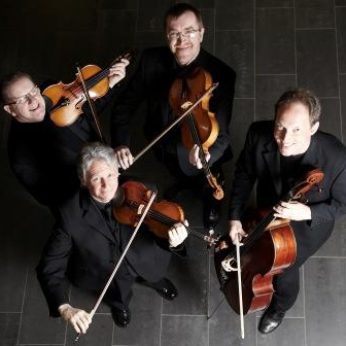Three new, very long and difficult Beethoven violin quartets dedicated to the Russian ambassador, Count Razumovsky, are attracting the attention of all connoisseurs. They are profound in conception and admirably written but not generally comprehensible. Allgemeine musikalische Zeitung 27 February 1807
This contemporary review reminds us of a time when Beethoven was a new music composer whose works were considered to be difficult verging on the incomprehensible. Now Beethoven’s quartets are core repertoire, familiar to all chamber music lovers but still as demanding for the listener as for the player.
The very opening of the work points to the future, the almost abstract sound of two strong chords, followed by a rest and then a miniature motif barely two bars long. This is hardly the stuff of a classical first subject and yet both motif and chords become essential parts of the unfolding drama generating tremendous energy as well as unexpected harmonic moves. The second subject is equally energetic if rather less abrupt and substantially more good-humoured, but concludes with a rhythmically powerful march-like section that relates back to the opening. The development begins and ends with the hesitant and exploratory first subject and much is made of the opening chords and the march-like section. Just before the recapitulation the concentrated part writing and the extended use of chords in cross rhythm reaches an altogether new level of complexity. After this climax the revisiting of the original exposition seems quite straightforward. The coda savours all this movement’s abrupt changes of mood and texture before suddenly collapsing.
The serene and solemn Adagio is simply one of Beethoven’s great slow movements. The noble chorale-like progression of the music reflects the stately dance of the constellations in the clear night sky. It is by far the longest movement in the quartet, but you would still wish it to last longer. It is cast in the same mould as the late E flat major Quartet’s slow movement with its dicing with infinity.
The Allegretto third movement returns to the restless brevity of expression of the first movement with a high-spirited figure with the accent on the off-beat forming the matter for discourse. We are still in E minor, adding to the strangeness of this unusual dance. The Trio in E major sounds even stranger by reason of its normal flowing Russian theme with its delightful fugal entries and its humorous conclusion, such melodic pleasure is suddenly out of place amongst the gruff, deaf composer’s new experiments. We get to hear the trio twice, the threat of the third hearing averted at the last second.
There are more surprises in the Finale apart from the maniacally energetic dotted rhythm of the subject itself. In order to increase the tonal tension of a work all of whose movements are in E minor, he begins this last movement in C major, which leads to a series of unexpected harmonic tricks throughout before finally resolving in favour of E minor.
